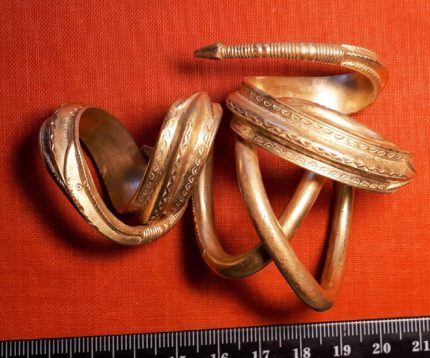 A metal detector hobbyist has discovered a rare 1,700-year-old gold collar in Estonia. On September 8th, Jegor Klimov was exploring a field at the ancient sacrificial site of Saaremaa as part of a search team led by archaeologist Marika Mägi when his metal detector alerted. The team had already decided to pack up and leave, but Klimov started to dig and revealed a tell-tale yellow glint. Archaeologists joined in and excavated a coiled up ring of gold with a serpent head on one end.
A metal detector hobbyist has discovered a rare 1,700-year-old gold collar in Estonia. On September 8th, Jegor Klimov was exploring a field at the ancient sacrificial site of Saaremaa as part of a search team led by archaeologist Marika Mägi when his metal detector alerted. The team had already decided to pack up and leave, but Klimov started to dig and revealed a tell-tale yellow glint. Archaeologists joined in and excavated a coiled up ring of gold with a serpent head on one end.
The collar dates to the Roman Iron Age, around the 3rd century A.D. Neck rings from this period were marks of high rank in Scandinavia, the more complex the design and construction, the more elite the wearer. Almost all the ones that have been discovered were found in bogs; none of them were found in graves. A few more simple arm rings and neck rings have been found in cremation burials. Studies of artifacts have found that objects buried in bogs were not, as a rule, the same as those buried in graves. Votive deposits were more precious, the best possible objects dedicated as sacrifices at sacred sites. Of the 60 or so extant gold neck rings from the Scandinavian Iron Age, almost all of them have been found in Sweden and Denmark. A handful have been found in Finland; one in Poland. This is the first of its kind found anywhere else in the Baltic states.
Very few artifacts from this period have been discovered in Estonia and gold objects from any period are extremely rare in the Estonian archaeological record. They can literally be counted on the fingers of one hand. At 175 grams in weight, this piece is the heaviest, most valuable gold archaeological artifact ever found in Estonia and must have belonged to someone of the highest rank among the Nordic elite. Its discovery supports the hypothesis that what is now western and northwestern Estonia had meaningful cultural contact with the peoples around the Baltic Sea and in Scandinavia as well as with the tribes in the modern-day Baltic states and Russia.
The Saaremaa piece may have been a bracelet, spiral collar or necklace. It’s difficult to say because, as is common with sacrificed objects, it was deliberately deformed, but its heavy weight and length suggests it was probably a neck ring.
“One can say that this is likely the most valuable single find,in the material sense, to be unearthed in Estonia,” Mägi explained to ETV news broadcast “Aktuaalne kaamera.” “It is believed that whoever wore these, they were a symbol of belonging to the highest echelons of society. So these are not regular bracelets. How this particular bracelet ended up in Saaremaa is an exciting question in its own right, and one we’ll likely never get a real answer for. This is a type of jewelry which throughout Scandinavia is considered one of the most significant items of the Roman Iron Age, and it is associated with royal power and royal families.”
